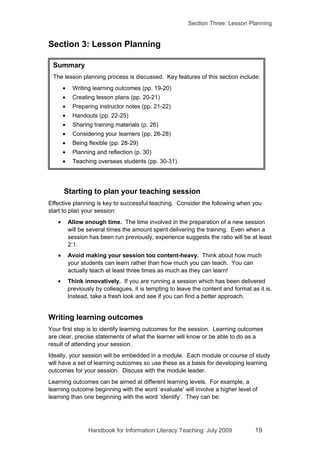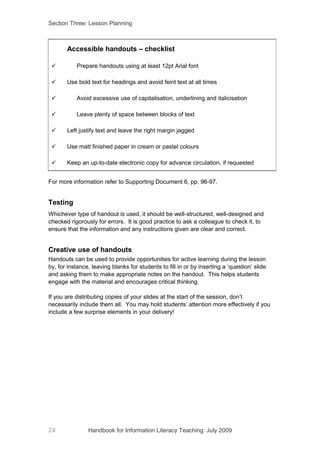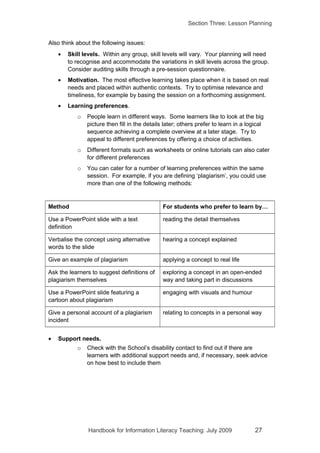This document provides guidance on lesson planning for information literacy teaching. It discusses writing learning outcomes, creating lesson plans, preparing instructor notes, and creating various types of handouts. Key recommendations include writing student-centered learning outcomes, including essential elements in lesson plans and instructor notes, preparing clear and accessible handouts, and considering learners' skill levels, motivation, preferences, and potential support needs.




![Section Three: Lesson Planning
• As a worksheet / workbook to be completed by the students as a
session progresses. See Example 7, pp. 115-118, Example 8, pp. 119-120,
Example 9, pp. 121-122 and Example 10, pp. 123-126.
• As a combined workbook and permanent source of reference. See
Example 11, pp. 127-133 and Example 12, pp. 134-138.
• As an activity sheet to spark discussion amongst students. See
Example 13, pp. 139-140.
• As an evaluation aid / checklist. See Example 14, pp. 141-142 and
Example 15, pp. 143-144.
Preparing handouts
Consider identification and layout:
• Include your name or initials, your library and the date of preparation, and
also the course of study, the module and the title of the session
• When sessions are embedded within a teaching module the School may
require the handout to follow its house style
• Handouts must conform with the requirements of the current INSRV
Communication and Style Guidelines which are available on the
Communications section of insrvSpace.
Bear in mind the requirements of the Disability Discrimination Act (DDA).1 This
places a duty on all educational institutions to make reasonable adjustments so that
disabled learners are not put at a substantial disadvantage. Learners who are
dyslexic, have concentration difficulties, or are visually impaired will benefit from the
following measures:
1
Disability Discrimination Act 1995 [online]. Available at:
http://www.opsi.gov.uk/acts/acts1995/1995050.htm [Accessed: 6 August 2009] as amended
by the Special Educational Needs and Disability Act 2001 (SENDA) [online]. Available at:
http://www.opsi.gov.uk/acts/acts2001/20010010.htm [Accessed: 6 August 2009] and the
Disability Discrimination Act 2005 [online]. Available at:
http://www.opsi.gov.uk/ACTS/acts2005/20050013.htm [Accessed: 6 August 2009].
Handbook for Information Literacy Teaching: July 2009 23](https://image.slidesharecdn.com/section31-130225202131-phpapp02/85/Section-3-1-5-320.jpg)




![Section Three: Lesson Planning
o The Disability Discrimination Act (DDA)2 places a duty on all
educational institutions to make reasonable adjustments so that
disabled learners are not put at a substantial disadvantage
o When designing activities, consider the demands on all learners’
capacities such as vision and hearing, concentration and stamina,
social skills and awareness
o General principles for planning accessible teaching sessions include:
Creating a logical structure
Making handouts available in advance, either electronically or
in paper form
Using multiple modes of communication
Varying methods of presentation
Planning mini-breaks or changing activity types
Incorporating checks on learner understanding so you can
monitor the effectiveness of your communication
Ensuring your plan is flexible so you can offer options to
learners.
For further information see Supporting Document 5, pp. 94-95
Being flexible
Your learning outcomes can be achieved in a variety of ways. Build some flexibility
into your plan so that you can react to the situation on the day.
• Allocate free time. If your session is 90 minutes long, plan for 70 minutes of
lesson content. Allow 5 minutes at either end for students to arrive/leave and
save the remaining 10 minutes to be used elsewhere in the session. This
might be used to:
o Give the students a break if necessary
o Review progress with the class: are you meeting the learning
outcomes?
• Prepare extra material
o To have further activities available for quick learners if they complete
the scheduled work
2
Disability Discrimination Act 1995 [online]. Available at:
http://www.opsi.gov.uk/acts/acts1995/1995050.htm [Accessed: 6 August 2009] as amended
by the Special Educational Needs and Disability Act 2001 (SENDA) [online]. Available at:
http://www.opsi.gov.uk/acts/acts2001/20010010.htm [Accessed: 6 August 2009] and the
Disability Discrimination Act 2005 [online]. Available at:
http://www.opsi.gov.uk/ACTS/acts2005/20050013.htm [Accessed: 6 August 2009].
28 Handbook for Information Literacy Teaching: July 2009](https://image.slidesharecdn.com/section31-130225202131-phpapp02/85/Section-3-1-10-320.jpg)




